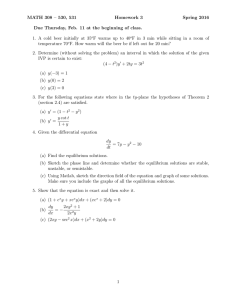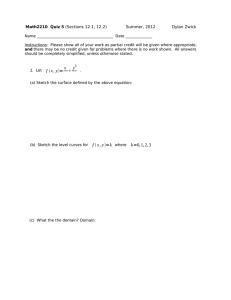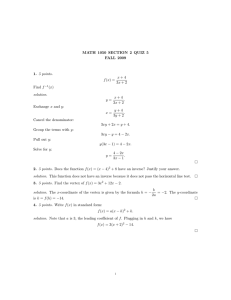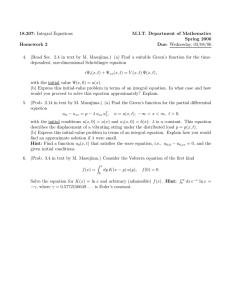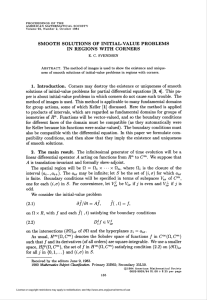Exam #1 Solutions
advertisement
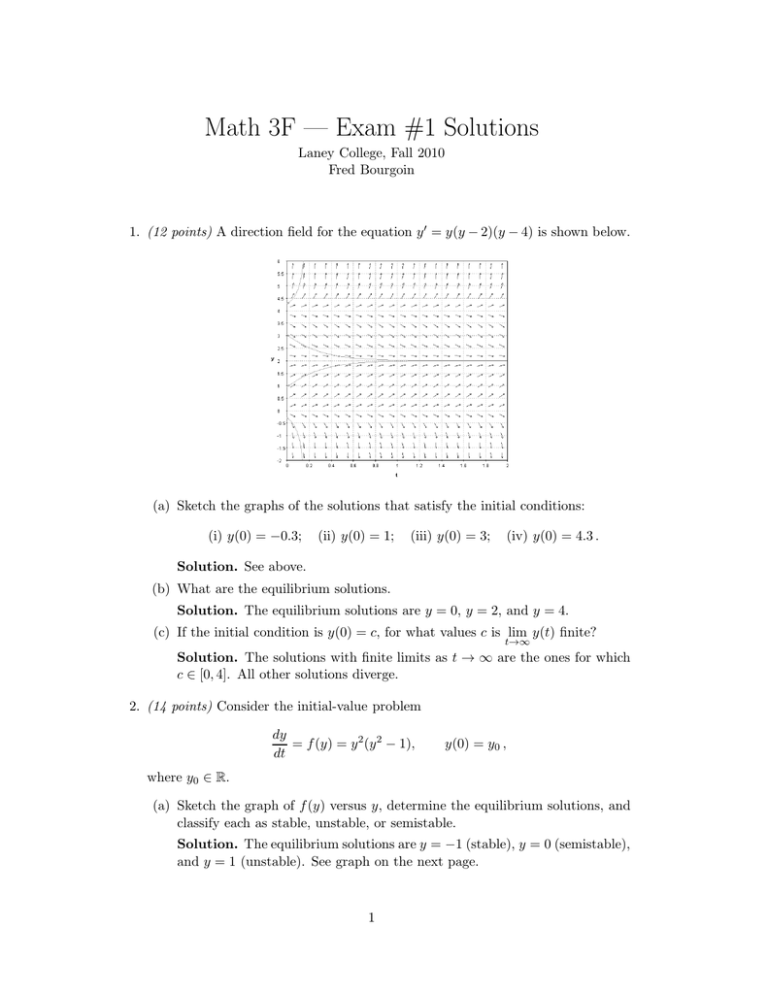
Math 3F — Exam #1 Solutions Laney College, Fall 2010 Fred Bourgoin 1. (12 points) A direction field for the equation y 0 = y(y − 2)(y − 4) is shown below. (a) Sketch the graphs of the solutions that satisfy the initial conditions: (i) y(0) = −0.3; (ii) y(0) = 1; (iii) y(0) = 3; (iv) y(0) = 4.3 . Solution. See above. (b) What are the equilibrium solutions. Solution. The equilibrium solutions are y = 0, y = 2, and y = 4. (c) If the initial condition is y(0) = c, for what values c is lim y(t) finite? t→∞ Solution. The solutions with finite limits as t → ∞ are the ones for which c ∈ [0, 4]. All other solutions diverge. 2. (14 points) Consider the initial-value problem dy = f (y) = y 2 (y 2 − 1), dt y(0) = y0 , where y0 ∈ R. (a) Sketch the graph of f (y) versus y, determine the equilibrium solutions, and classify each as stable, unstable, or semistable. Solution. The equilibrium solutions are y = −1 (stable), y = 0 (semistable), and y = 1 (unstable). See graph on the next page. 1 f (y) y −1 0 1 (b) Sketch several graphs of solutions in the ty-plane. Solution. Here is what DFIELD gave: 3. (14 points) Find an explicit solution to the initial-value problem: x dx + ye−x dy = 0 , Solution. The equation is separable. Z Z xex dx = − y dy =⇒ y(0) = 1 . 1 (x − 1)ex = − y 2 + C . 2 To find C, use the initial condition: 1 −1 = − + C 2 =⇒ 1 C=− . 2 Finally, to get an explicit solution, solve for y: 1 1 (x − 1)ex = − y 2 − 2 2 =⇒ =⇒ y 2 = 2(1 − x)ex − 1 p y = 2(1 − x)ex − 1 . Note that we have to choose the positive square root because of the initial condition. 2 4. (4 points) Without solving the initial-value problem, determine the largest interval on which the solution is certain to exist. t(t − 4) y 0 + y = 0, y(2) = 1 . Solution. If we rewrite the equation in the form y0 + 1 y=0 t(t − 4) we see that the coefficient function we usually call p(t) has discontinuities at t = 0 and t = 4. By the existence/uniqueness theorem for linear equations, and since the initial condition is given at 2, we know for certain that the IVP has unique solution which exists throughout the interval (0, 4). 5. (14 points) With no initial capital, I invest k dollars per year (in a continuous manner) at an annual rate of 7.5% (compounded continuously). If my goal is to retire with $1,000,000 in 25 years, what should k be? Solution. If we let y(t) be the amount (in dollars) I have saved at time t years, then dy = k + 0.075 y , y(0) = 0 . dt The equation is separable, so Z Z 1 dy = dt =⇒ ln |k + 0.075 y| = t + C k + 0.075 y 0.075 k =⇒ y = Ce0.075 t − . 0.075 Notice that the equation is also linear, so we could have solved it using the ink tegrating factor technique. Plugging in the initial condition, we get C = 0.075 , so k y(t) = (e0.075 t − 1) , . 0.075 In order to have $1,000,000 after 25 years, y(25) = k (e0.075(25) − 1) = 1,000,000 0.075 =⇒ k= 75,000 ≈ $13,584.94 . −1 e1.875 6. (14 points) Solve the initial-value problem: ty 0 + (t + 1) y = t , y(ln 2) = 1 , t > 0. Solution. Dividing the equation by t, we see that it is linear: Since Z t+1 dt = t y0 + t+1 y = 1. t Z 1 1+ t 3 dt = t + ln t + C , an integrating factor is µ = et+ln t = t et . Multiplying the equation by the integrating factor yields (t et y)0 = t et t et y = (t − 1) et + C =⇒ =⇒ y= t−1 C + t. t te Now plug in the initial condition: y(ln 2) = C ln 2 − 1 + =1 ln 2 2 ln 2 Therefore, the solution is y = =⇒ C = 2. 2 t−1 + t. t te 7. (12 points) Solve the differential equation: y + 6x dx + (ln x − 2) dy = 0 , x x > 0. Solution. The equation is exact since y 1 + 6x = = (ln x − 2)x . x x y So, there exists a function ψ such that ψx = y + 6x x =⇒ ψ = y ln x + 3x2 + h(y) =⇒ ψy = ln x + h0 (y) . but ψy = ln x − 2. So, h0 (y) = 2 and h(y) = 2y. Hence, the solution is defined implicitly by ψ = y ln x + 3x2 + 2y = c . 8. (16 points) Use the method of Picard’s iteration to find successive approximations φ0 (t), φ1 (t), φ2 (t), and φ3 (t) to the solution of the initial-value problem: y 0 = t2 y − t , y(0) = 0 . Solution. Start with φ0 (t) = 0, then Z t Z t (s2 φn (s) − s) ds . f (s, φn (s)) ds = φn+1 (t) = 0 0 We already have φ0 (t). Now, 2 t Z t s t2 (−s) ds = − φ1 (t) = =− , 2 0 2 0 5 t Z t 4 s s s2 t5 t2 φ2 (t) = − − s ds = − − =− − , 2 10 2 0 10 2 0 8 t Z t 7 4 5 2 t8 s s s s t5 t2 s =− − − s ds = − − − − . and φ3 (t) = − − 10 2 80 10 2 0 80 10 2 0 4 EC. Solve 4x3 3 + 2 y y dx + 3x + 4y dy = 0. y2 Solution. The equation is not exact, but multiplying it by y 2 will fix that: (4x3 + 3y) dx + (3x + 4y 3 ) dy = 0 , . Now that the equation is exact, proceed as usual. ψx = 4x3 + 3y =⇒ ψ = x4 + 3xy + h(y) =⇒ ψy = 3x + h0 (y) = 3x + 4y 3 =⇒ h(y) = y 4 =⇒ ψ = x4 + 3xy + y 4 Hence, the solution is defined implicitly by ψ = x4 + 3xy + y 4 = c . 5
